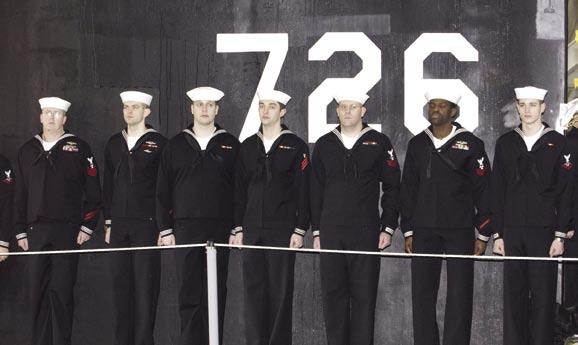
3 minute read
USS Ohio, 1st Guided-Missle Platform, Rejoins Fleet
Photo by Ray S. Narimatsu
USS USS Ohio, 1st Guided-Missile Platform, Rejoins Fleet Ohio, 1st Guided-Missile Platform, Rejoins Fleet
Advertisement
(above) Sailors assigned to the guided-missile submarine USS Ohio (SSGN-726) man the rails for the boat’s return to active service ceremony held on board Naval Base Kitsap Bangor.
(below) Vice Chairman of the Joint Chiefs of Staff, Adm. Edmund Giambastiani, Jr., talks about the importance of the guided missile submarine (SSGN) program at the return to service ceremony for Ohio.
Photo by Ray S. Narimatsu
The first of four Ohio-class TRIDENT missile submarines being converted to carry guided missiles and Special Operations Forces (SOF) rejoined the fleet in a return to service ceremony at Naval Base Kitsap-Bangor Feb. 7, 2006. In December, USS Ohio (SSGN-726) completed conversion to a guided-missile submarine capable of carrying more than 150 Tomahawk cruise missiles and more than 60 SOF members for extended periods. This conversion is a major step forward in the Navy’s ability to fight the Global War on Terror. During the ceremony, guest speaker Adm. Edmund P. Giambastiani, vice chairman, Joint Chiefs of Staff, spoke of the new role Ohio will have as it steers towards danger, rather than away from it:
“As it became clear our deterrence goals had been met, our Congress authorized the conversion of these four boats to support SOF strikes. This platform has truly been a case study in transforming our military capabilities to meet the future needs of our joint forces. In doing so, Ohio has proven our concepts are validated as the SSGN prepares for our uncertain future by being on station and providing a forward deployed presence, adaptability and modularity that are exactly the kind of capabilities our Quadrennial Defense Review calls for.”
“Ohio’s return to service is truly monumental. In the span of a little more than three years, we have taken a proven weapon system and completely changed its operating paradigm,” said Rear Adm. William H. Hilarides, Program Executive Officer (Submarines). “Now Ohio will conduct missions that will have a direct impact on the on-going Global War on Terror and, because of its payload capacity, Ohio and the other three SSGNs will free up Navy assets in the near future. SSGNs are truly force multipliers.”
Instead of 24 TRIDENT C-4 Submarine Launched Ballistic Missiles, Ohio and the other three SSGNs – USS Michigan (SSGN-727), USS Florida (SSGN-728), and USS Georgia (SSGN-729) – can carry 154 Tomahawk land-attack cruise missiles and 66 Special Operations Forces (SOF) for extended periods of time.
Two of the SSGN’s missile tubes are dedicated lock-in/lock-out chambers which will allow combat swimmers to leave the submarines while submerged. To further support SOF, the ships will accommodate up to two Dry Deck Shelters, two Advanced SEAL Delivery Systems, or one of each atop the lock-in/lock-out chambers. The remaining 22 tubes will each be
Photo by Chief Petty Officer (SW/AW) Dave Fliesen
(above) Petty Officer 3rd Class (SS) Zachary Foran (left) stands the Helmsman watch while Chief Petty Officer (SS) Richard Cregor gives him orders as he supervises the helm and stern planes aboard Ohio prior to her return to service ceremony.
(bottom left) Petty Officer 2nd Class (SS) Michele Angel mans a Tactical Tomahawk Weapons Control System (TTWCS) console in the Attack Weapons System aboard Ohio prior to her return to service ceremony.

Photo by Chief Petty Officer (SW/AW) Dave Fliesen

able to hold up to seven Tomahawk missiles or specially designed stowage containers for SOF equipment.
The SSGNs will also play an integral role in joint operations. With two High DataRate Antennas, improved Intelligence, Surveillance, and Reconnaissance capabilities, and the new Common Submarine Radio Room, SSGNs will be able to host a Joint Task Force command element
Annie Glenn, the ship’s sponsor, presented the crew with a ship’s patch worn by Sen. John Glenn on his return to space in 1998. The patch was autographed by all seven astronauts aboard the shuttle and will now be displayed in the wardroom.
Michigan, Florida, and Georgia are scheduled to return to service over the next two years.
Petty Officer 1st Class Howlett is the assistant public affairs officer for COMSUBGRU-9 in Bangor, Wash.







